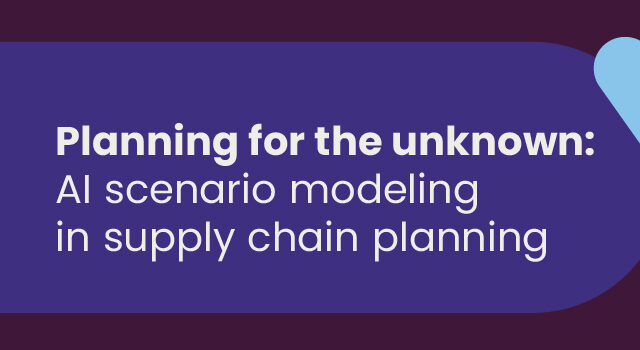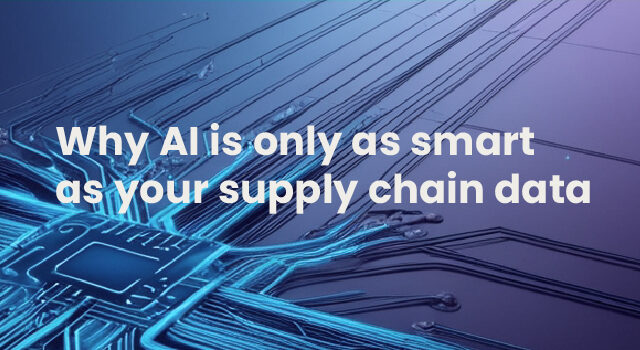Machine learning isn’t reserved for tech giants or futuristic operations. It’s already at work in many supply chains today, often behind the scenes.
For small and mid-sized businesses (SMBs), machine learning delivers smarter forecasting, faster planning, and reduced daily chaos of managing inventory. This technology is reshaping how planners and buyers make decisions by learning from data and continuously improving supply chain performance.
With that in mind, let’s explore how machine learning actually works in a supply chain context and dive into how it’s already making a measurable impact on daily operations for SMBs.
What’s in this blog?
Key takeaways
- Machine learning is a type of artificial intelligence technology that allows systems to learn from historical data without explicit programming.
- By handling large amounts of data and adapting more nimbly than manually managed spreadsheets, machine learning supply chain technology improves forecasting accuracy, reduces time spent on analysis, and more.
- The benefits of machine learning aren’t theoretical; real-world examples showcase how tools with inherent machine learning capabilities improve SMB operations without increasing headcount or complexity.
- Netstock’s Predictor IBP® has built-in machine learning capabilities, which make adoption accessible and simple.
What is machine learning – and why it matters in supply chains
Machine learning is a type of artificial intelligence technology that uses historical data to find patterns and make decisions. In other words, it helps systems “learn” from past inputs to make better decisions over time. What makes machine learning really valuable is that the tech doesn’t need to be explicitly programmed for every scenario.
Those new to the technology can compare machine learning to how streaming services suggest your next movie. By looking at your past choices, the systems can suggest something you’re likely to watch.
Machine learning in supply chains works the same way. It looks at your sales history, identifying patterns in demand, supplier performance, and inventory behavior, to help you forecast more accurately, identify problems before they happen, and respond faster.
Unlike basic automation or spreadsheet formulas, machine learning responds to change and gets smarter over time. It picks up on new patterns in seasonality, demand swings, or delays, and adjusts recommendations accordingly. For inventory planners and supply chain managers, that means better visibility, fewer surprises, and evidence-based decisions.
4 ways machine learning transforms daily supply chain operations
Machine learning in supply chains sounds technical, but in practice, it makes everyday work more manageable without additional effort from managers or inventory buyers.
Here are four ways it’s already helping supply chain teams today.
1. Forecasting smarter, sooner
Machine learning doesn’t rely on a single forecasting formula. Instead, it compares multiple models against your product data and chooses the one that fits best. Depending on the unique SKU and associated data, machine learning can consider stable demand, seasonal spikes, or unpredictable trends all at once. This means more accurate forecasts that adjust as conditions change.
2. Automatically sizing safety stock
One size doesn’t fit all when it comes to safety stock. Machine learning analyzes supplier performance, lead time variability, and demand volatility to identify just-right buffer levels. This means fewer stockouts and less excess inventory gathering dust. Machine learning supply chain technology helps managers and planners strike a smarter balance than traditional spreadsheets alone have ever been able to.
3. Detecting exceptions and anomalies
Planners don’t have time to sift through every number. Even if they did, it’s hard to catch every sudden change in data manually. Machine learning is about learning patterns over time. From that learning, the algorithm becomes smarter and makes suggestions based on what it has learned. These learnings help you act fast on potential disruptions without drowning in data. Plus, with extra time saved by machine learning technology, you have the flexibility to dive in and investigate anomalies as needed.
4. Supplier performance & lead time adjustments
Every supply chain professional knows that not all suppliers are consistent. Lead times change. Supplier reliability fluctuates. This can have serious impacts on your business.
To reduce the impact, reduce guesswork, and minimize delays, machine learning technology continuously tracks and learns from real supplier performance data. This learning helps fine-tune your replenishment plans. It can also account for variability and lateness, so you’re not caught off guard when issues arise.
Real SMB impact: Machine learning without the complexity
While all of this might sound complex, the reality is quite simple. Machine learning technology is a part of many inventory management solutions.
This should reassure SMBs who have yet to invest in the tech. Machine learning doesn’t have to mean building custom algorithms or hiring a data science team. For small and mid-sized supply chains, it’s already being used behind the scenes in tools that are simple to use and easy to adopt.
Netstock’s ML in action
Netstock’s Predictor IBP® solution integrates machine learning into its demand planning solution. It’s not a separate module or confusing add-on, but an integral part of how the system works. Those that adopt it won’t be writing formulas or uploading spreadsheets. Instead, the software will automatically evaluate your data in the background.
Because it’s embedded directly in the platform, everything happens in a familiar interface with clear, visual dashboards. You’re not looking at raw algorithms; you’re seeing forecasts you can trust, exceptions that need your attention, and orders you can act on confidently.
Results for SMBs
As noted, machine learning is more or less a hidden tech that works in the background. Still, in daily operations, the benefits of machine learning are clearly visible.
Benefits show up in the metrics that matter, including:
- Higher fill rates, with fewer emergency orders
- Reduced inventory investment without increasing risk
- Faster reaction to demand changes or supplier issues
- More time focused on execution and decision-making—not manual planning
These aren’t hypothetical results. They’re based on real-world examples where supply chain teams have improved performance without increasing headcount or technology complexity.
Read how SMBs like yours benefit from Netstock
The benefits of machine learning for daily supply chain operations
These benefits aren’t only about long-term transformation. They’re about making your current processes more efficient and less stressful, too.
Here’s what that looks like in practice:
- Forecasts that update daily, automatically: Instead of waiting for monthly cycles or manually adjusting spreadsheets, machine learning updates your forecasts based on the most recent data.
- Fewer surprises in inventory performance: Whether it’s a sudden spike in demand or a delayed shipment, machine learning helps catch potential issues earlier, giving you time to respond.
- Less time planning, more time executing: Automated recommendations and exception alerts reduce time spent sorting through data, so your team can focus on solving problems and driving improvements.
- Smarter order suggestions: Recommendations are based not only on current stock levels but also on lead time trends, demand shifts, and item-specific behavior.
- Higher confidence in decisions: When your tools are learning from your actual operations and adapting as things change, it’s easier to trust the data and explain your decisions to leadership or suppliers.
These aren’t abstract benefits. For supply chain teams at small and mid-sized businesses using machine learning supply chain management technology, they show up in shorter planning cycles, fewer manual errors, and smoother communication across the supply chain.
Getting started with machine learning – no data scientist needed
You don’t need a background in data science or a dedicated IT team to start using machine learning in your supply chain. With the right tools, the setup is straightforward.
Netstock was built for small and mid-sized businesses that want smarter planning without the complexity. Our solution connects directly to your existing ERP system, with no need for custom integrations or months-long implementations.
Once connected, the system begins analyzing your historical data, identifying trends, and recommending better planning decisions.
With Netstock, implementation looks like:
- Plug-and-play integration: No heavy lifting on your end. Our tool integrates with most leading ERPs, and setup is typically measured in days, not months.
- A clear, visual interface: You won’t be staring at formulas or raw data. Dashboards and reports are designed for supply chain professionals, not data analysts.
- Built-in education and support: You don’t have to figure it out alone. Netstock provides onboarding, ongoing support, and guidance to help you understand how to use machine learning insights in your planning process.
See Netstock in action
With Netstock, machine learning isn’t a separate tool that needs to be managed on top of daily operations. It’s part of how the platform works. This allows your team to benefit from better forecasting, smarter inventory decisions, and early warnings without having to build anything from scratch.
Final thoughts: Machine learning for the real world of SMB supply chains
Machine learning for supply chain management isn’t a future concept or a luxury reserved for enterprise operations. It’s already helping teams at small and mid-sized businesses work more efficiently, plan more accurately, and respond faster to change.
The technology itself doesn’t need to be complicated. With the right tools, machine learning works quietly in the background, supporting better decisions every day. It’s not about replacing people. It’s about giving planners and buyers more clarity, fewer surprises, and more time to focus on the work that moves the business forward.
Netstock’s Predictor IBP® has machine learning built into the tool. This means there’s: No custom setup, no complex dashboards, no specialized expertise required.




